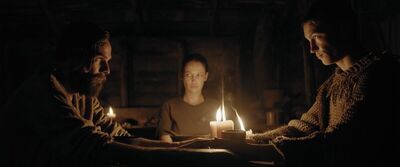Gaia

“Gaia” is a trip. Literally. Magic mushrooms are involved. Pop a hallucinogenic substance and the world might look something like “Gaia,” where, in the Tsitsikamma forest in South Africa, a fungi of monumental proportions proliferates at night, gathering strength, threatening to take over the earth. Throw in a couple of wandering half-human half-mushroom creatures, and you’ve got yourself a trip and a half. Directed by Jaco Bouwer, “Gaia” has a lot to say about humanity’s destruction of the environment, about the “tipping point” we have collectively reached in the Anthropocene, but the film says it with creativity, mad flights of imagination, and even humor. “Gaia” does not feel like homework. It’s a thought-provoking and disturbing experience rather than a lecture.
The opening scene is straight out of Joseph Conrad’s Heart of Darkness: two people paddle down a river in a canoe. The river is crowded in on all sides by thick jungly green. It’s a lonely sight, often presented from a God’s eye view (appropriate since these two people are operating a drone, buzzing above and around them). Winston (Anthony Oseyemi) and Gabi (Monique Rockman) both work for the forestry service, and when their drone disappears in the forest, Gabi decides to get out of the canoe and go find it. Winston warns her of the dangers. Gabi is adamant: the drone is now “trash” and they mustn’t leave their trash behind. What is meant to be a quick errand turns instantly into a confusing incoherent nightmare, when Gabi encounters (a nice way to put it) a couple of survivalists: father Barend (Carel Nel) and son Stefan (Alex van Dyk). The two emerge, dirt-covered, rail-thin, wielding hand-made tools, draped in rags, like cavemen of yore. Winston, meanwhile, sets off into the forest to find his colleague. Big mistake.
When night falls, the forest transforms into a sentient being, crawling with mysteries, mushrooms curling upwards, with long twirling fronds taking on a life of their own. (The visuals are extraordinary.) Gabi is alarmed by all the squeaking sounds out there, sudden shrieks, whooshes of movement in the trees, and sometimes—eerily—a glowing red light emanating through the thick cover. Holed up in Barend and Stefan’s shack, Gabi slowly begins to understand that “something” is out there, something unstoppable. Barend and Stefan are fully aware of what it is, what it wants, and how it works. Gabi’s learning curve is slow. Winston’s is fast.
Getting out of the forest will not be easy. Gabi is sucked into the tense controlling dynamic of father and son. When Gabi, in the process of trying to connect with the wordless Stefan, shows him her cell phone, Barend grabs it and throws it across the room, shouting like an old-time preacher: “Abomination! Devilish!” The three sit down to a meal and Barend intones a prayer to the “Mother of creation and destruction.” Outside, the mushrooms are on the move, gigantic endlessly-tentacled figures rustling around behind the characters, mostly seen in a blur (a much scarier choice than seeing them up close and personal). Screenwriter Tertius Kapp gives us a good understanding of how these creatures work, and how Barend and Stefan have figured out how to survive. It’s complicated! Gabi learns by watching.
“Gaia” is rich with references, Heart of Darkness being the most obvious. There are also shades of “Deliverance” (all those bows and arrows and wilderness injuries, not to mention an encounter with an unstoppable “Other”), and shades of “The Mosquito Coast,” where a madman father holds his naive son (and everyone around him) in thrall, more cult-leader than parent. “Gaia” is also, with a couple of quirks, a good old-fashioned monster movie. But the film is up to something far beyond a simple cross-genre exercise. The warnings about what humanity has done to the earth power “Gaia” with urgency and terror, but Kapp complicates matters by putting the “sermon” about environmental devastation into the mouth of a fanatic, shouting about all the “whores and false goddesses” living out in the modern world. He is a wild-eyed Abraham, willing to present a human sacrifice to the ravenous Fungi God.
“Gaia” was shot by cinematographer Jorrie van der Walt, and the images have an eerie tactile quality, dense with detail and texture: the thick hard cords of tree bark, the green pond-scum moving sluggishly, the mushroom spores floating ominously through the blackness, little orange mushrooms springing out of a branch, the spinning cosmos above the trees. There are numerous dream sequences, or perhaps hallucinations due to all the mushroom dust floating around, and these are terrifying and often beautiful: mushrooms pushing out of Gabi’s arm, her hands plunged into thick black mud; Barend fornicating wildly with a hole in the dirt; Gabi lying naked beside a crystal-clear pond, the water calm and still. These sequences are very unnerving.
The “message” of “Gaia” is simple, and yet it’s told in a way that complicates and maybe even obscures the message. That’s not necessarily a bad thing. What one is really left with is the image of all of those mushrooms, spreading around trees, pushing their way up, blindly seeking more and more space. It’s us or them. Sylvia Plath wrote a poem from a mushroom’s point of view. Its closing lines:
“We are meek,
We are edible,
Nudgers and shovers
In spite of ourselves.
Our kind multiplies:
We shall by morning
Inherit the earth.
Our foot’s in the door.”





